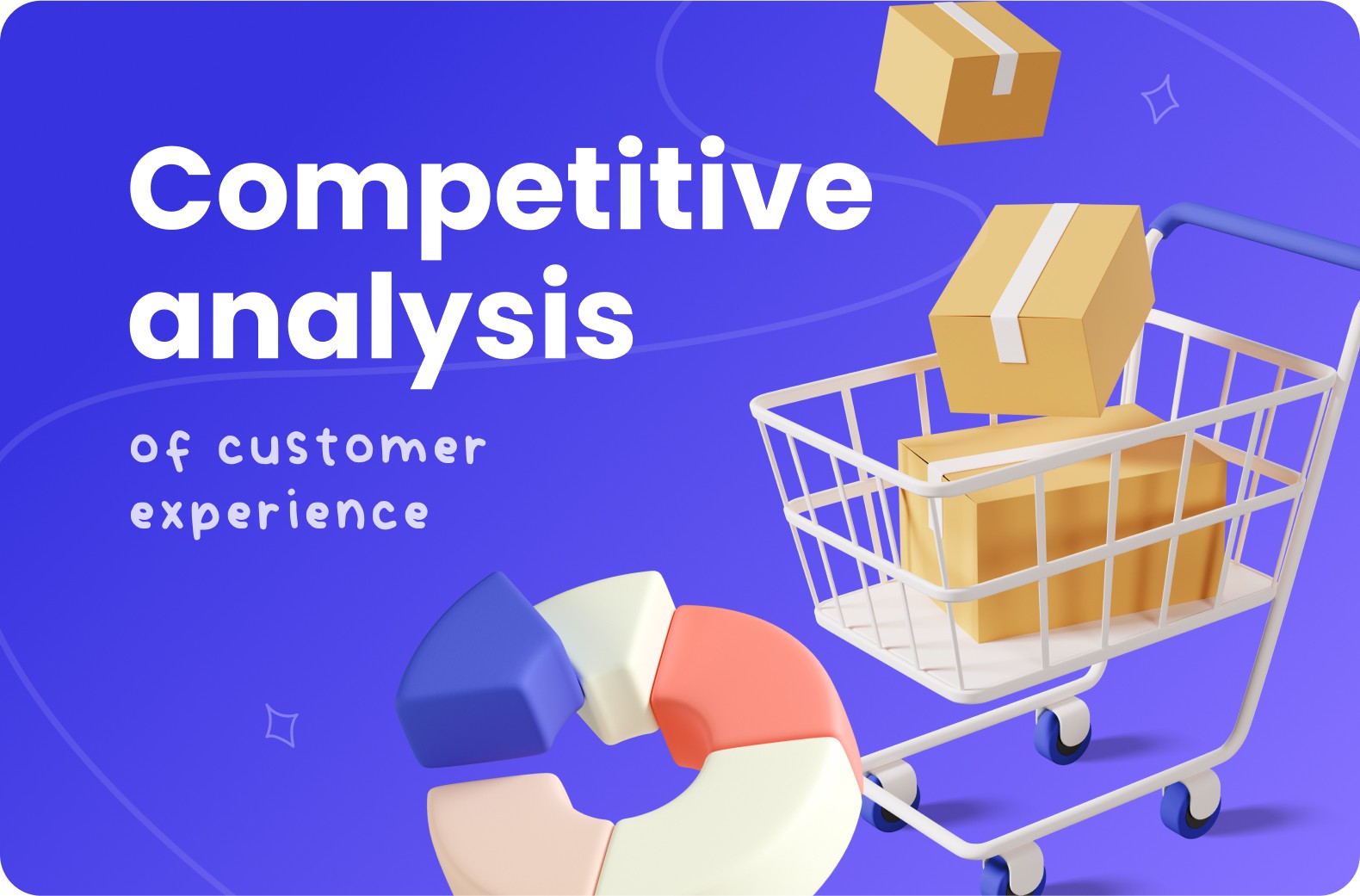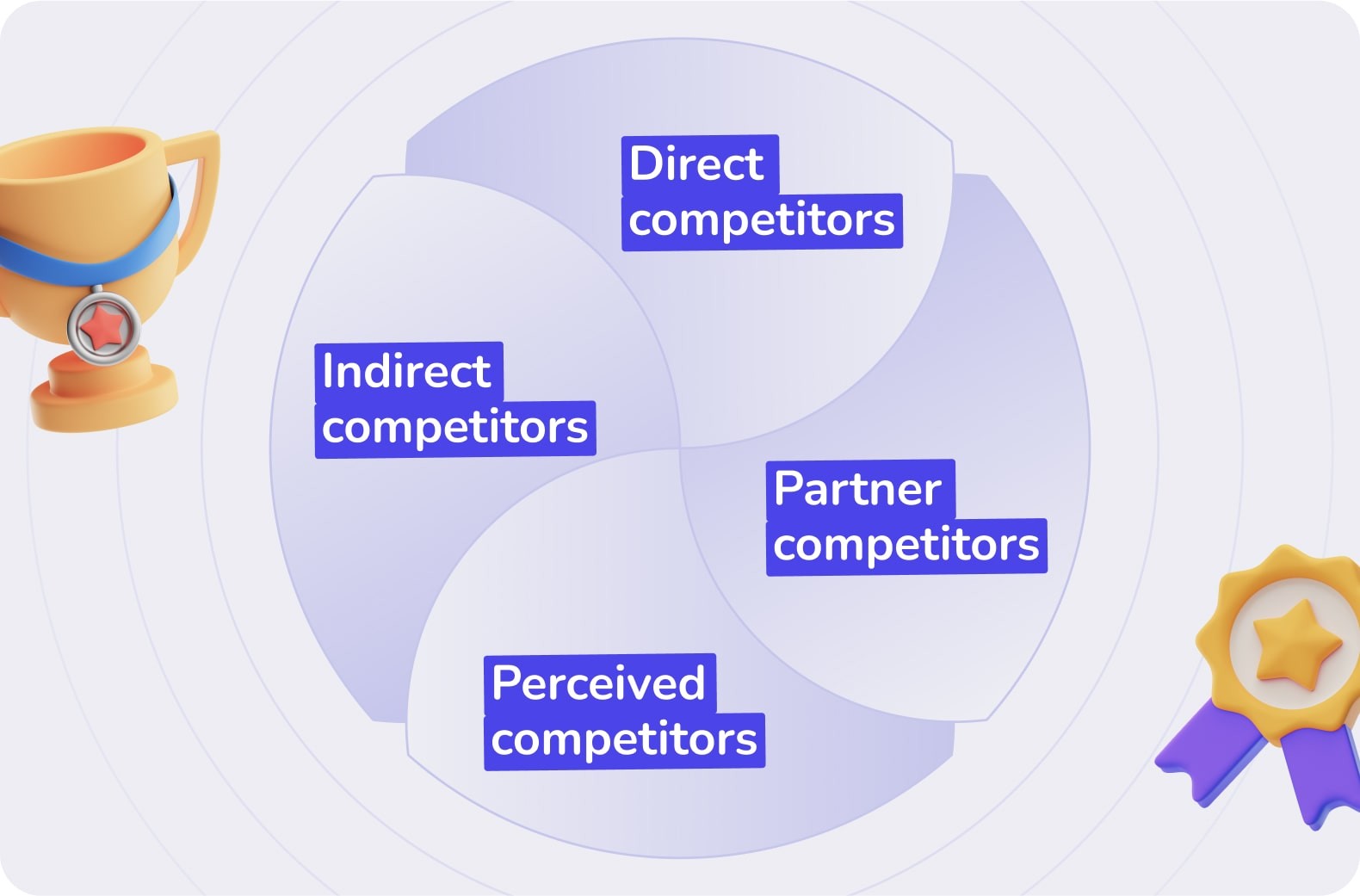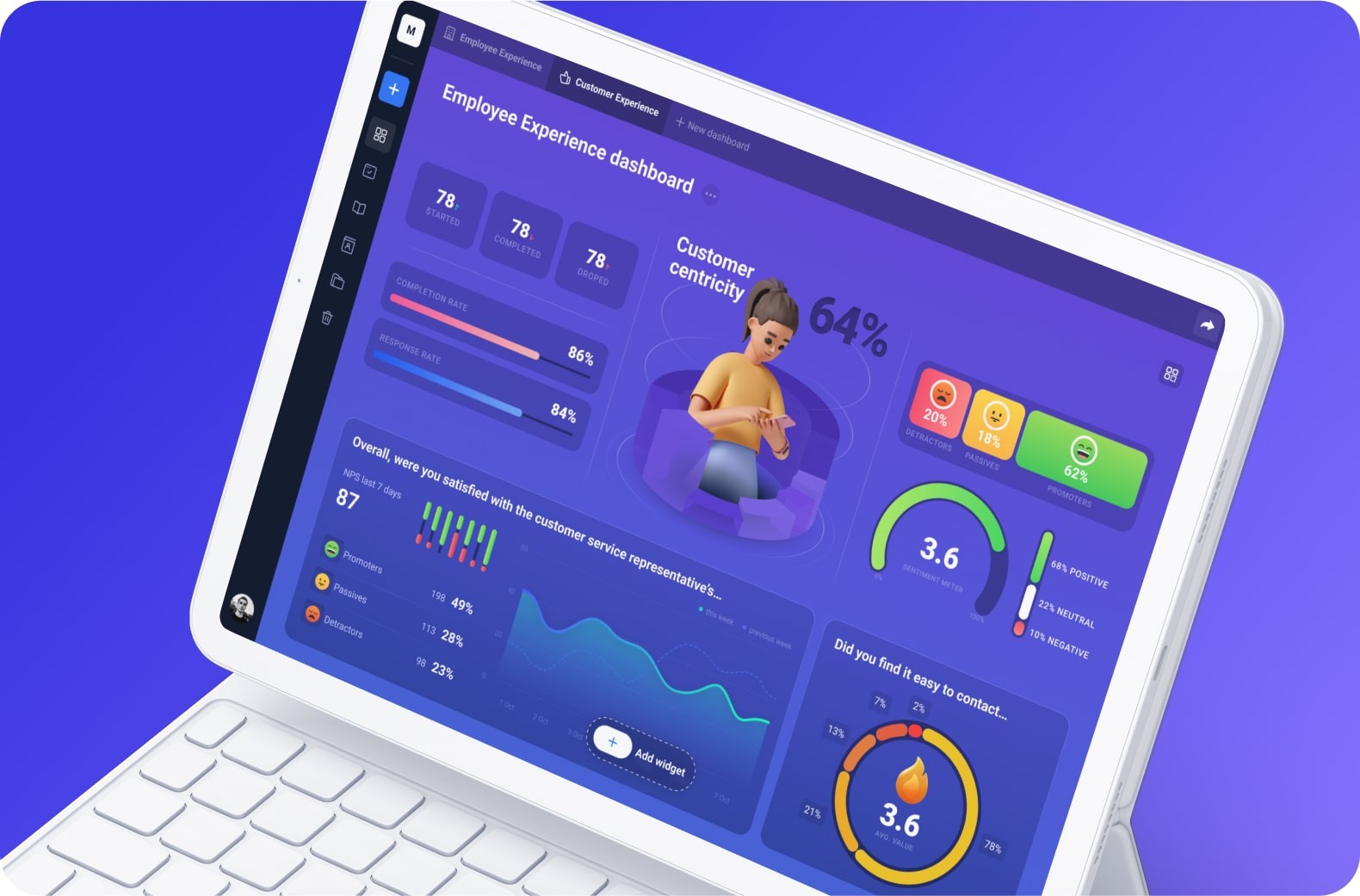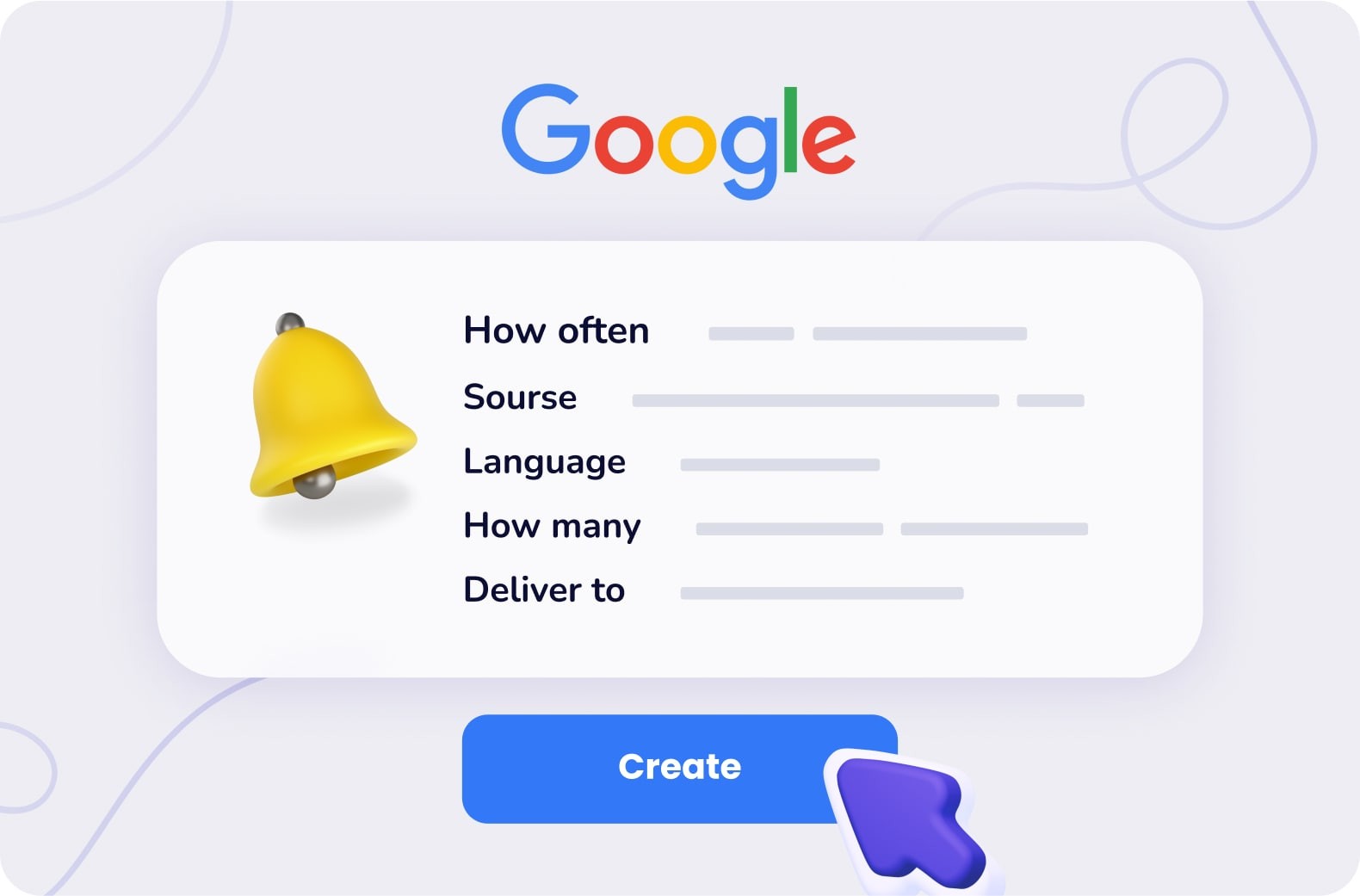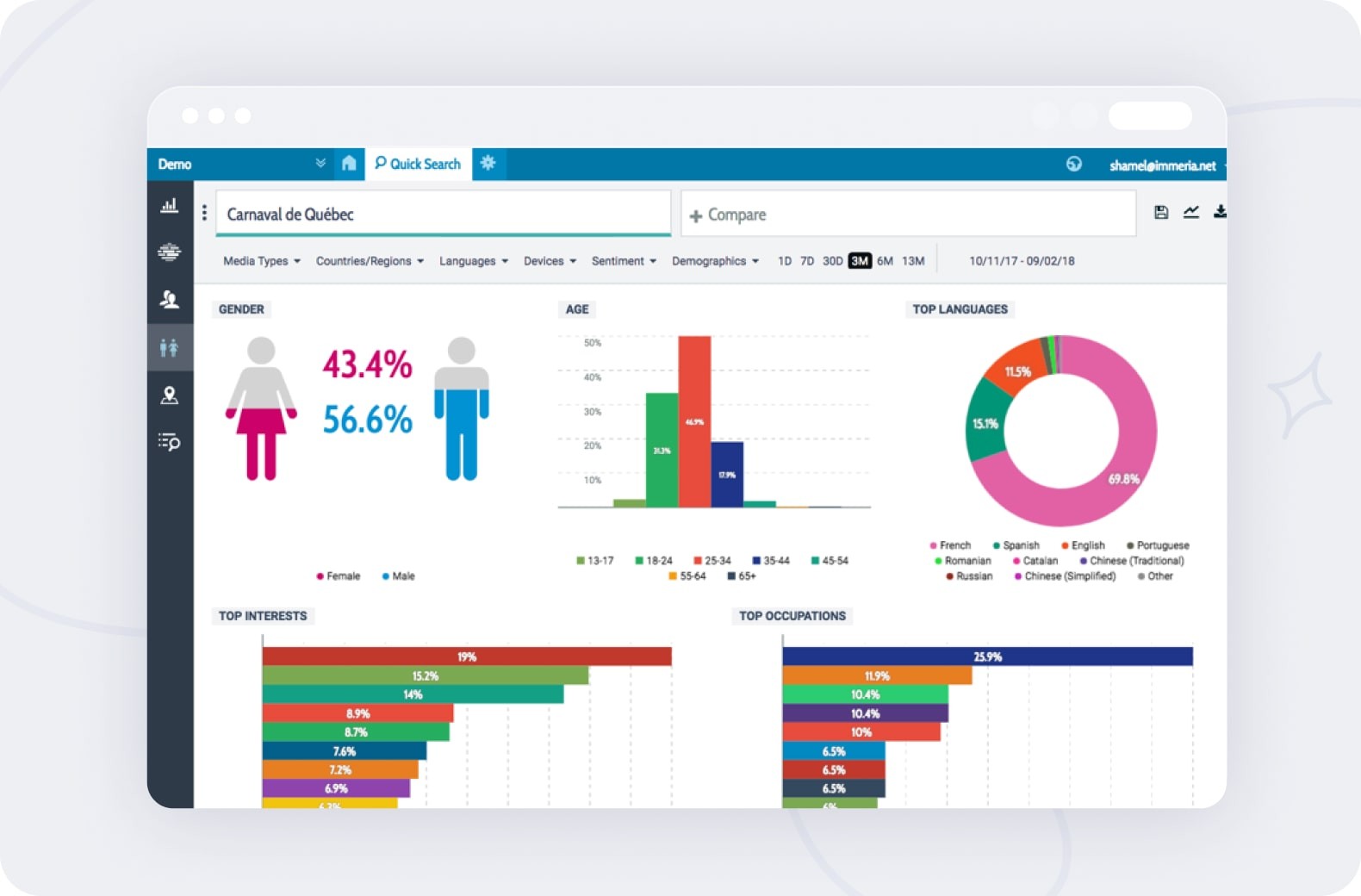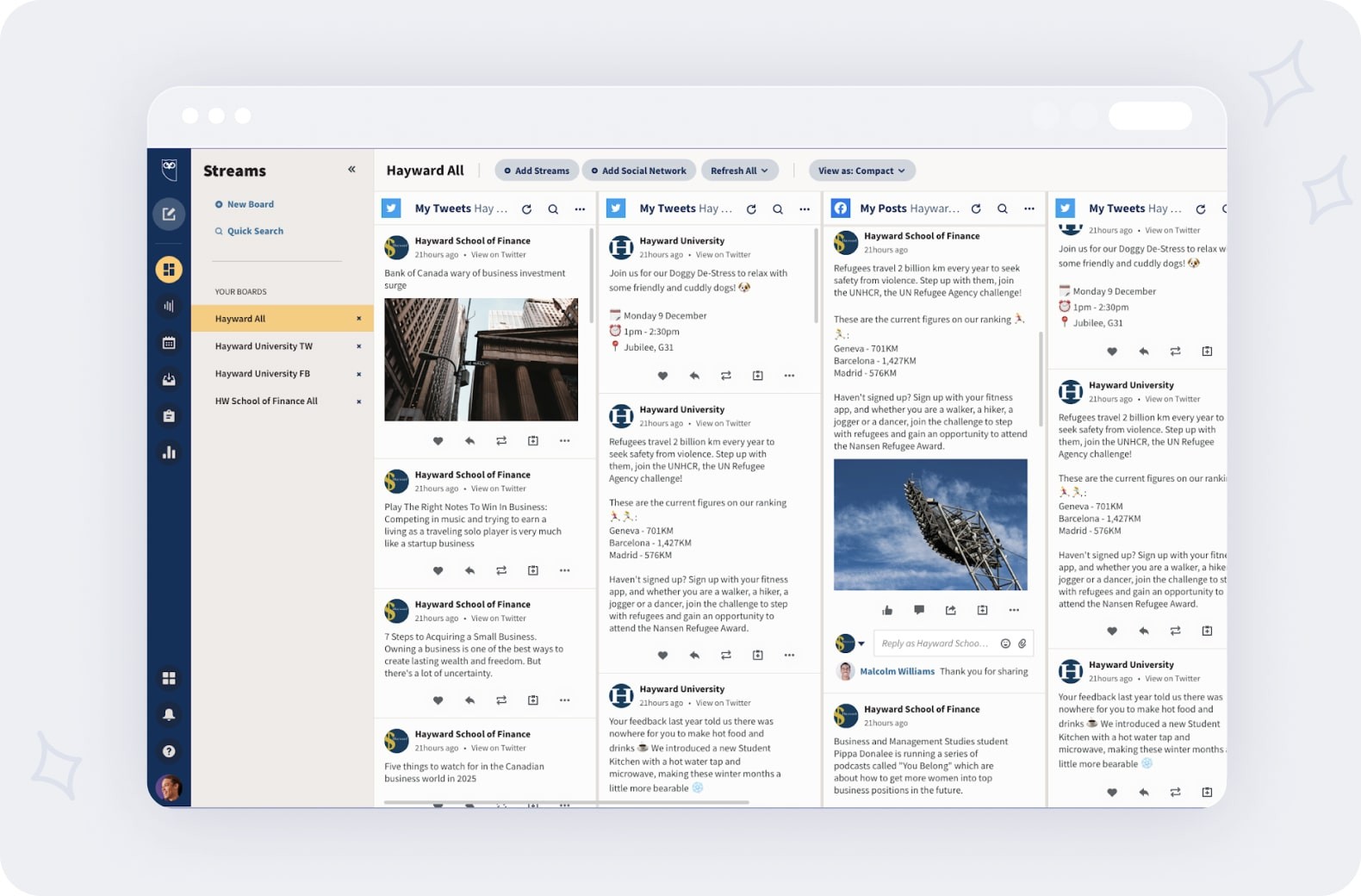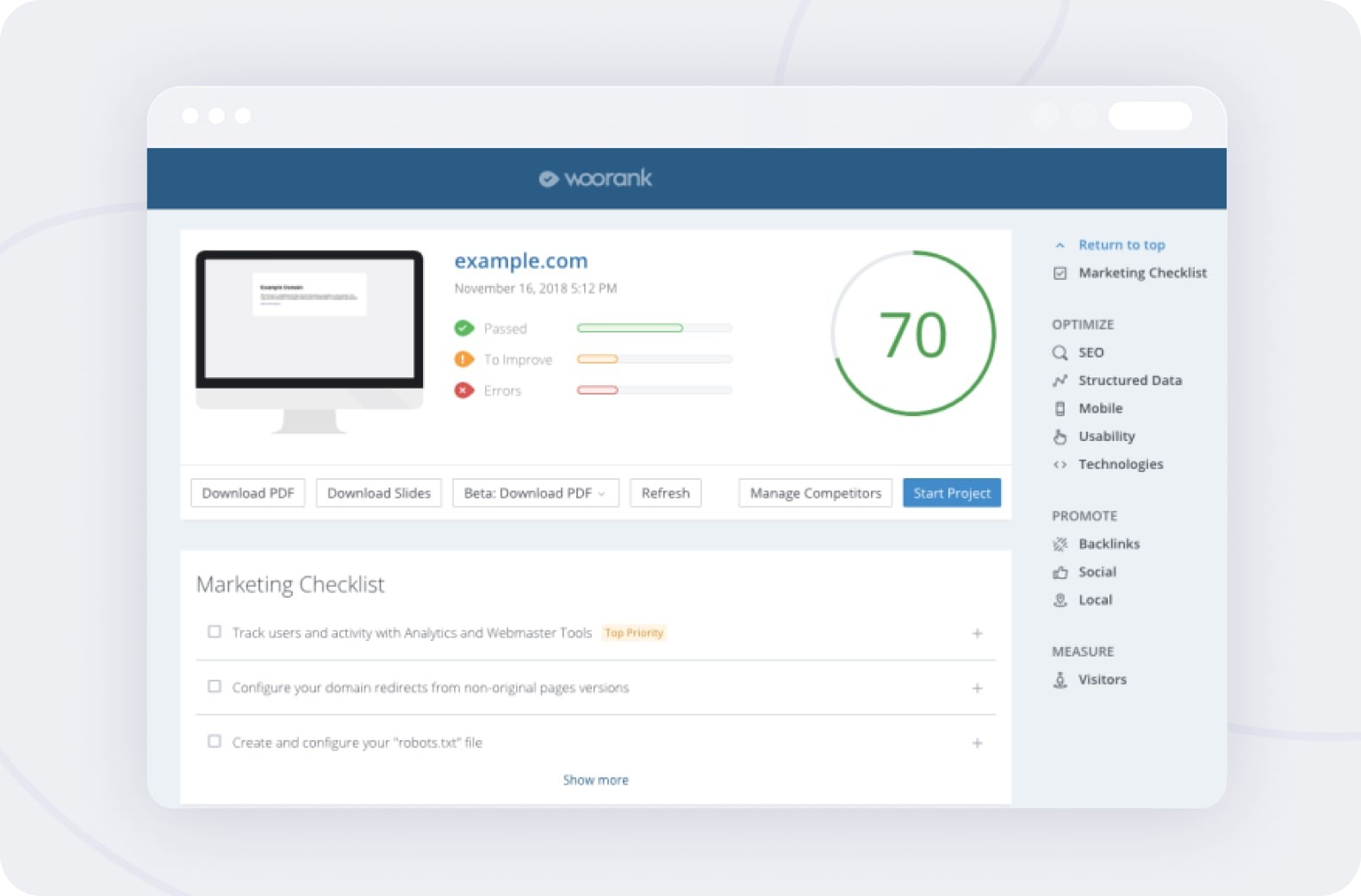What is competitor analysis?
Competitor analysis is an ongoing process of assessing the strengths and weaknesses of your competitors to identify opportunities and potential threats.
You could conduct a competitor analysis on how a business is marketing itself, using social media, or branding its products or services. Still, it’s especially effective when used in the customer experience arena.
By understanding what your competitors are doing well and where they’re falling short, you can adjust your practices, ensuring your customer experience is the best it can be.
What are the four types of competitors?
Understanding each of themallows you to prioritize which businesses you’re focusing your competitive analysis on, therefore helping you identify the unique opportunities that could provide a competitive edge.
Direct competitors
Direct competitors are businesses that offer the same products or services as you and compete for the same customers. They are the parallel companies to your business, like Coca-Cola and Pepsi, or Nike and Adidas. However, these could be any size, have any market share, operate in any country, and have any target market (but the closer to your target market they are, the more directly in competition with you they’ll be). It’s essential to monitor these businesses as they directly impact your own success.
Indirect competitors
These businesses don’t offer the same product or service options as you do, but that doesn’t mean you aren’t still competing for the same customers. For example, if you’re a clothing retailer, your indirect competitors could be businesses that sell accessories or footwear. Even though you’re not selling the same thing, you’re still competing for the customer’s money, have a similar target market, and will provide very similar customer experiences.
Perceived competitors
Perceived competitors are the most difficult to identify because you need to put yourself in the eyes of your customers rather than looking through the lens of your own business and beliefs.
For example, if you’re selling a multivitamin product, you perhaps wouldn’t see food companies as your competitors. Still, if your customers know that you could get their vitamin C from both products, they would be in competition with them in the eyes of your customers. Therefore, it’s important to consider carrying out a competitive analysis on them and their marketing strategies. Other examples of this kind of competition could include:
- Buying gardening equipment or hiring a professional service
- Installing a fence or planting a hedge
- Buying security cameras or getting a guard dog
- Using a car wash or purchasing a pressure washer
Partner competitors
Interesting, not all competitors are bad news, and joining forces and having strategic partnerships with them could be one of the best moves you could make. For example, Apple products use Samsung OLED displays. General Motors and Toyota cross parts to manufacture cars.
GoPro and Redbull are fantastic examples and have been working together for many years and have generated some truly incredible results.
Again, you may not be directly competing with these businesses, but it’s important to be aware of them as they could have an impact on your relationship with customers and the experience you’re offering, therefore, to offer consistency and ensure you’re on the same page, you may want to analyze their customer experience practices.
Overall, you’re going to want to mainly focus on conducting a competitive analysis on your direct and indirect competitors since these will be the biggest threats. If you have a special reason to, or identify a unique opportunity, then you’ll want to analyze the others.
Why conduct a competitor analysis?
There are several reasons why you should conduct a competitor analysis of customer experience and plenty of benefits you could enjoy as a result.
To understand the market
By understanding your competitors, you can better understand the overall market. This can help you to identify trends and opportunities that you might not have been aware of otherwise, enabling you to adjust your approach to customer service and improve where you’re falling short.
For example, if you analyze a competitor and they’re not responding to customer queries about their products or services quickly (or at least in the timeframe that customers are expecting). you could improve your response times and market yourself as being there for your customers when they need you. Thus, you gain a competitive edge.
To benchmark your own performance
A competitor analysis can help you to benchmark your own performance against your competitors. This can be a useful exercise to see where you need to improve to better meet your customers’ needs. Carrying out an analysis may instantly highlight areas where you’re falling short, allowing you to improve and overcome the obstacles that could be holding your business back.
To identify threats
Competitor analysis can also help you to identify potential threats. By understanding what your competitors are doing, you can make sure that you’re prepared for any changes in the market. If, for example, a competitor seems to be jumping on a social trend (such as offering customers the ability to help out and donate some of their spendings to a global cause), you can react quickly and effectively to ensure you don’t fall behind.
To discover new opportunities
Finally, a competitor analysis can help you to find new opportunities. By understanding your competitors’ strengths and weaknesses, you can identify areas where you can offer a better product or service. This could be an opportunity to enter a new market or to improve your own offerings.
When should you do a competitor analysis?
There’s no set time frame for conducting a competitor analysis. However, it’s generally a good idea to keep an eye on your competitors and review your performance regularly. This will help you to identify any changes in the market and make sure that you’re prepared for them.
The best way to think of this process is not one that you just carry out, and then you’re done forever. Instead, it’s a regular, ever-evolving process that needs to be optimized, streamlined, and continued. Businesses are constantly changing, adapting, evolving, and updating their processes, and you need to be aware of what’s going on, so you stay competitive and ahead of the industry curves.
How to conduct your own competitor analysis
Okay, let’s get into the fun stuff – creating your competitor analysis framework that evaluates their customer experience against yours. Don’t worry, it’s not a complicated process, as we’ll showcase here our actionable, step-by-step guide.
Step 1: Benchmark your business
First and foremost, you need to understand what your customer experience looks like through the eyes of your customers. This means conducting surveys, reading reviews, checking your reputation on social media, and getting any kind of feedback showcasing how your customers feel about the experience you’re offering.
Are they happy? Dissatisfied? Do they want more? Are there one or two areas they want improvements? Are there some specific customer advisors in your team causing problems? Are customers waiting too long?
This should be a continuous process you go through anyway, but if you’re not already, gather information about your experience and see where you’re at, what you do well at, and how you can improve.
Step 2: Identify your competitors
Next, identify your direct, indirect, and perceived competitors. There’s no point in analyzing every business under the sun; rather, you need to be concise and specific with your efforts.
Create a list of competitors (direct and indirect first) as they’re your main competition, as you share a target market, and prioritize analyzing these businesses and what they’re up to. To be the better business, you must ensure you’re matching these businesses and ideally exceeding what they’re capable of providing.
From here, you can head into analyzing your other kinds of competitors, especially if you get wind that they’re offering a fantastic customer experience.
Step 3: Collect the data
Once you’ve identified your competitors, It’s time to conduct the analysis itself, figuring out what weaknesses, opportunities, and threats are out there.
There are endless ways to do this, whether you’re doing the research yourself or using specific analysis tools (more on this below). Look at reviews of what target customers think, identify what kind of experience they’ve had, and see what features they’re offering on their website.
Pay attention to social media posts (especially Twitter and Facebook) to see how the business responds and whether customers are happy. Are they sharing their problems and pain points on a product or service on offer, and is the company responding?
What channels are your competitors offering for customers to get in touch, how fast are they responding, or do customers feel it’s impossible to get ahold of anyone?
The more information you gather within your competitive analysis framework, the clearer your image of your competitor’s customer experience, and the more actionable your response and improvements can be.
Step 4: Analyze the data
Once you’ve collected the data, start analyzing it. You’ll probably get a clear idea of what works and what doesn’t as you’re doing your research. What are a company’s strengths, and what do its marketing tactics achieve? How does what your competitors do affect their market share and put them in the position they’re in?
Still, once you’ve gathered information on multiple competitors, you can start cross-analyzing everything and build up a detailed picture of the current state of the whole industry. Take time to understand your competitors’ strengths and weaknesses, identify any areas where you could improve your own offering, and encourage growth.
Step 5: Identify opportunities and threats
The aim of the game is to look for ways you can improve your customer experience to meet or exceed the expectations of what your competitors are offering. You want to get your marketing to the top of its game and get your customer reviews shining the best they can for the benefit of your business. You’re looking for ways you can improve your own experience, as well as looking for potential threats that could set you back or stunt your growth.
A competitive analysis example here for your business could look like improving the way you react to product or service complaints. This could mean speeding up your response times, improving the training of your sales team, updating your business name for better brand recognition, or revising how you allocate your business resources.
Step 6: Take an action
And once you’re clear about what’s happening in all businesses, including your own, the final step is to take action and put your new changes into effect via your business plan or adapting your marketing efforts and sales approach.
This could mean investing in new technology or services, training (or retraining) your staff, upgrading the way you currently do things, hiring more staff, adjusting your branding or tone of voice, and so on. With the changes in place, you should start to see an improvement in your customer experience and overall reputation, thus receiving a considerable boost in your business’s success.
Collect data with these competitor analysis tools
If conducting a competitor analysis sounds like a lot of work, remember that plenty of tools can help streamline the process and ensure you get the best results. Here are some of the best competitor analysis tools that you can use:
Screver
Evaluating the customer experience is vital because if you don’t know where your business is and how you’re operating, you can’t compare it to how your competitors are doing. You won’t have a foundation that details whether you’re providing a good or bad experience.
Screver makes this easy. Effortless, in fact. Screver enables you to assess and improve your customer experience by providing feedback from real customers who are working with your business easily and effectively. You can set up lightning-fast, responsive surveys that gather the information and metrics that matter to you and execute them via whatever channels will get the best results for your customer base.
This fantastic competitive analysis tool puts the power of evaluating your own customer experience in your hands. It will deliver actionable results that give you a real insight into how your business operates and what reputation you have.
Google alerts
A simple yet powerful tool that all businesses of any size should be using, Google Alerts is a free tool that allows you to track mentions of your competitors online. This can be a useful way to collect data on your competitors’ marketing and customer service and provides a fundamental insight into what conversations are happening around your competitor’s businesses and your own. This is hand’s down one of the best free tools out there, so make sure you’re using it!
Quick search
Quick Search works in real-time to show you insights on multiple brands simultaneously, detailing information on reputation, influencer messaging, how blogs, articles, and your competitors’ websites are mentioning brands, and what conversation is happening.
This is essential because, to understand the customer experience your competitors are providing, you must understand how they’re talking about themselves and being talked about online.
Are they present in the discussions? Do people have positive or negative things to say? What kind of messaging, tone, and branding are they using?
Quick Search provides all of this information in an easy-to-digest format, so you can quickly get an overview of how your competitors are faring. It’s very visual, very intuitive to use, and very powerful, giving you a competitive advantage in so many areas.
Hootsuite insights
The platform that all the big brands use. Hootsuite is a fantastic tool for social listening, allowing you to track, measure, and analyze your own social media conversations and that of your competitors, as well as identify their overall social media strategy.
Social media platforms are an excellent way for customers to share their experiences with businesses, therefore, they are one of the best ways to see how your competitors interact with their customers. Are they responsive? Do they engage in conversations, or do they just post one-way messages?
Hootsuite provides the answers, providing you with a competitive advantage in this vital domain.
WooRank
WooRank is a website analysis tool that provides insights into your competitor’s website traffic, SEO, social media, and more. It’s a great way to get an overview of how well your competitors are doing online and what areas they may outperform you in, whether that’s the products or services they offer, the way they react to industry trends, or even just rank in the search engine results.
Competitive analysis: your business edge
As you can see, competitive analysis is a powerful tool that can give you a natural edge over your competitors if you carry it out correctly, with the right tools, and get the most accurate information possible.
By understanding what your competitors are up to, including what they’re doing well and where they’re falling short, you can ensure that your customer experience is head and shoulders above the rest. And don’t forget evaluate your customer experience is the first step to take in any competitor analysis operation. Screver is the best tool to get the most accurate picture of what’s happening.
Check out Screver today to discover all the benefits and features it offers, and get ready to grow your business like never before!
